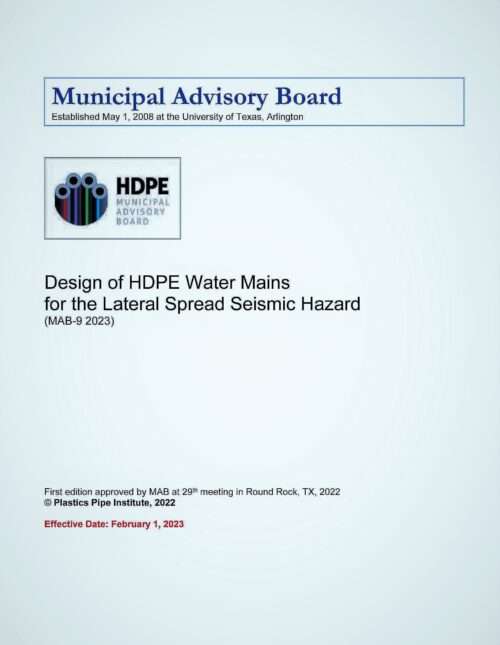New Technical Document Announced for the HDPE Pipe Use in Seismic Sensitive Areas

Provides Cost and Performance Ratio Data
IRVING, TX – The Municipal Advisory Board (MAB) of the Plastics Pipe Institute, Inc. (PPI) today announced the publication of a new technical document that provides data for high-density polyethylene (HDPE) water lines in earthquake sensitive areas. MAB-9, Design of HDPE Water Mains for the Lateral Spread Seismic Hazard is available for free on the group’s website.
“This is the first document of its kind that provides the rationale, data and formulas for determining the proper wall thickness for a fused, highly ductile, flexible HDPE water main in a seismically sensitive area, subjected to an induced lateral spread,” stated Camille George Rubeiz, P.E., F. ASCE, co-chair, Municipal Advisory Board and senior director of engineering, Municipal and Industrial Division of PPI.
MAB serves as an independent, non-commercial adviser to the Municipal & Industrial Division of PPI, the major North American trade association representing the plastic pipe industry.
The MAB-9 Task Group was made up of industry experts who volunteered their time. It was headed by Michael O’Rourke, Ph.D., P.E., F.SEI, M.ASCE, professor emeritus civil engineering, Rensselaer Polytechnic Institute (Troy, NY).
“Experience suggests that high-density polyethylene pipe does very well in earthquakes,” O’Rourke said, “but engineers like to have ways to calculate and substantiate their design. Listening to what somebody else says that, ‘Oh yes, the pipe is great’, but they still are faced with the question of ‘what wall thickness do I need?’ ‘I have this particular diameter pipe and it’s going to be buried this far underneath the ground so what wall thickness do I need for some expected seismic event?’ The goal is to have HDPE pipe that will be able to withstand the expected earthquake loads on this inherently ductile material. With that in mind, MAB thought it would be useful to develop a document that provides designers with some relationships, tables, formulas, et cetera, that they can use to figure out how thick the wall would need to be for an expected lateral spread. And that’s the purpose of the MAB-9.
“HDPE is known as a continuous pipe, which means the pipe segments, which are 40 feet to 50 feet long, are fused together,” he continued. “The ductile iron or cast iron pipe has joints every 15 or 20 feet, and the damage from a seismic event frequently occurs at those joints. Continuous pipe, whether it’s welded steel or high-density polyethylene, usually does better than segmented pipe in earthquakes. HDPE has the added advantage over steel (and all other materials) in that it is highly ductile, flexible and corrosion resistant and so it can move with the earth as opposed to trying to resist the deformations that the earth is imposing on it.”
Rubeiz elaborated, “MAB-9 is essential for many reasons. Proper wall thickness is very important, especially with earthquakes, and ground movement. Plus, there continues to be a dire need to replace the aging infrastructure, especially pipes that are older and brittle that many seismic events will cause them to crack. HDPE pipe and the information contained in MAB-9 will help in those replacement programs to provide a proper and resilient water main system.
“We would also like to thank the other MAB members and supporting engineers who provided their time and expertise to the project – Robert Diamond, P.E., City of Palo Alto, CA; Casey Haynes, P.E., City Utilities, Springfield, MO; Bill Heubach, P.E., M. ASCE, Seattle Public Utilities, WA; Harvey Svetlik, P.E., GPPC, TX; and Gerry Groen, P.Eng., Infra Pipe Solutions, ON.”
MAB-9, Design of HDPE Water Mains for the Lateral Spread Seismic Hazard can be found at: https://www.plasticpipe.org/common/Uploaded%20files/1-PPI/MAB%20Publications/MAB-09/MAB-9%20Final%201-17-2023.pdf
About the Municipal Advisory Board:
The mission of the Municipal Advisory Board (MAB) is to improve the design, installation, and operation of municipal HDPE water piping systems through the creation of partnerships among utilities, researchers, designers, contractors, and the HDPE industry. MAB serves as an independent, non-commercial adviser to the Municipal & Industrial Division of the Plastics Pipe Institute, Inc.


